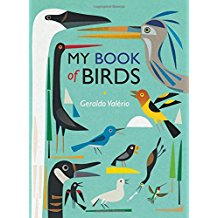
Publisher: Wren & Rook (part of Hachette Children's Group), London
Publication Year: 2017
Binding: 2
Page Count: 48
ISBN Number: 9781526360007
Price: £12.99
My Book of Birds
As a parent of a young son, I am always on the lookout for books to help me indoctrinate (I mean inspire) a love of birds. This book ticks many boxes. It is big, colourful, varied and with short and interesting snippets of information. Personally I really like the artistic style, colourful collages, in which the birds are depicted (with the exception being the hirundines which are not to my taste). As with all art though, the style will appeal to some and not others. The book covers one or two species from a range of families, including raptors, pelicans, hirundines, owls, hummingbirds, wrens, warblers, corvids, gamebirds, waterfowl, herons, shorebirds (gulls, terns, auks and waders), cranes, thrushes, finches and doves. It therefore offers a broad insight into a variety of shapes, sizes and ecological niches, but in a very easy-going style.
My overall feelings about this book are very positive, and I have found it useful in stimulating interest and subsequent conversations with my son, who is four. Its few shortcomings are seen through my eyes rather than through those of the intended audience. Firstly, there are a few factual inaccuracies. House Martins do not nest in houses, Great Black-backed Gulls do not have yellow legs, and Blackcaps do not, so far as I am aware, cache seeds. Secondly, although I find the balance of predominantly UK species with a few from overseas to be about right, I would have preferred if the foreign species had occupied a section of their own at the end rather being interspersed with native species. While reading to him, I was able to correct the few errors and let him know which he was likely to see in this country, so these points are not particularly important. You could argue that in talking about these details, he was learning about the importance of such things (or more-likely about the pedantic tendencies of his father!). A final quibble is that the recommended information sources do not list BTO. I am of course biased, but I regard BTO as the finest information source about UK birds!
In conclusion, for parents looking to inspire their children or grandchildren, I warmly recommend this book. Adults who enjoy art of this style will also enjoy leafing through, as I did, and some of the facts (most of which are correct) may well be new even to an adult reader. For example I did not know, I must confess, that Solitary Sandpipers nest in trees, nor that pigeons feed their young with a kind of milk secreted from their crop.
Book reviewed by Ben Darvill





Share this page